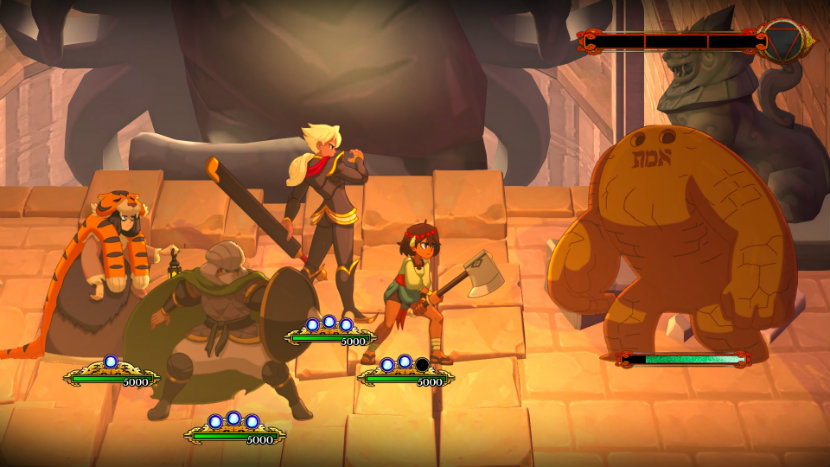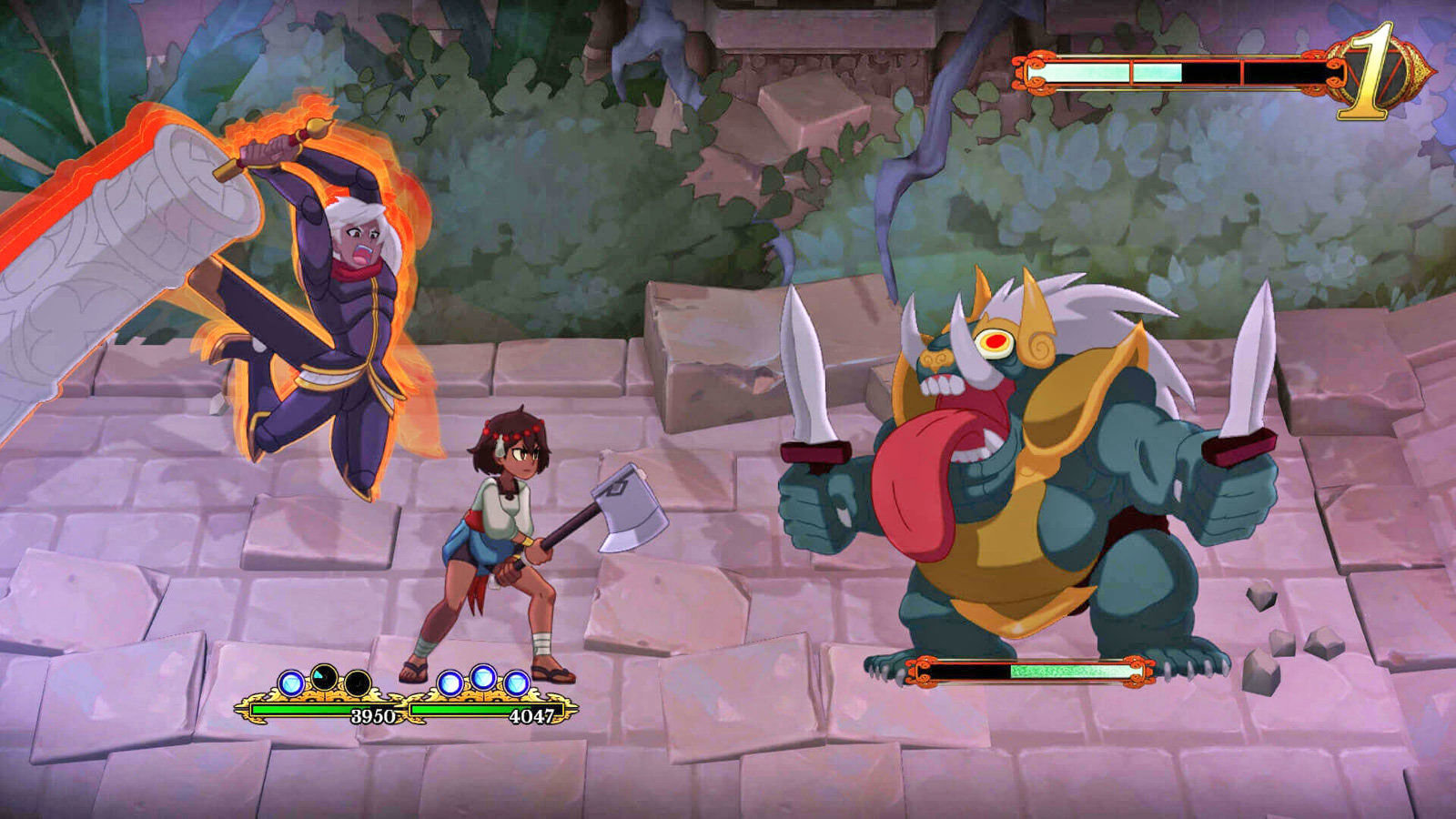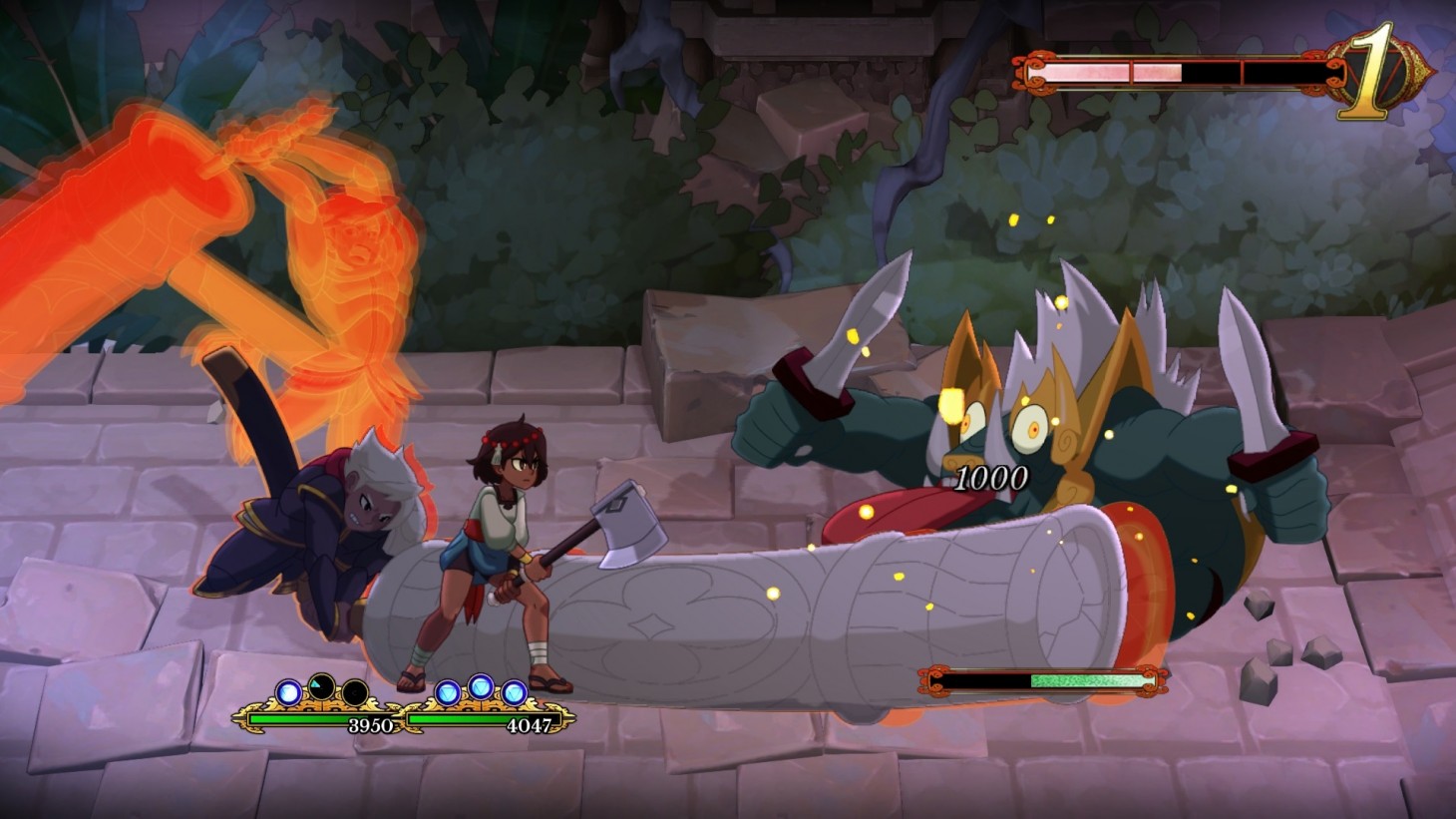Salsa is weird. It’s a bunch of stuff thrown together in a jar, often with a bizarre consistency, always vibrant with primary colors and strong flavors. You’d never eat it by itself because of its chunky, goopy physicality and acidic or spicy taste, but it’s great when you use it as a topping; but not just any topping, a “dip.” You take something salty like a chip and scoop that crap up like you’re bucketing dirty water out of a ground well. Yet as weird as it all is conceptually, if there’s a plate of chips and a can of salsa in front of you, you’re compelled on a primal level to consume all of it. Somehow this is a metaphor for how I feel about Indivisible.
Running, Jumping, and Grinding
Indivisible is from Lab Zero Games, the minds behind Skullgirls. While that game was a lightning-fast tribute to Marvel vs Capcom with a few of its own tricks, Indivisible has more in common with the original Valkyrie Profile. If you’ve played that, or any older Monolith Soft titles, you’ll know exactly what to expect from Indivisible. It’s also curiously similar to Idea Factory’s recent Super Neptunia RPG. It’s a lot like that game, except less bad. Like a lot less bad.
While it’s definitely a RPG, Indivisible’s structure exists entirely on a 2D plane. There is as much platforming, if not more, than there is combat. When you’re running around between objectives, Indivisible almost looks like a metroidvania. But that’s mostly surface-level aesthetics based on running through tunnels and glancing at a blocky map to know where you are. It’s pretty linear, and while there are secret collectibles and different traversal options, you aren’t exactly backtracking and unlocking new spaces with new abilities.
There is a lot of wall-jumping, however, and a cool double jump-like maneuver that has you using an axe to cling to walls. The platforming isn’t rewarding in the same ways a Metroid or Donkey Kong are, but it’s fast, responsive, and generally unobtrusive. Plus, Lab Zero’s distinct style and expensive-looking animation makes every second of gameplay into eye candy. Unfortunately, like many games with giant, hand-drawn characters combined with platforming, it can be extra hard to judge things like collision during tense moments.
Granted, tense moments are usually just about the transition into Indivisible’s combat system. When you encounter an enemy and either hit it or it hits you, the game seamlessly starts combat, which itself plays out in real time. Just like in Valkyrie Profile and similar games, once a character’s respective gauge fills, you can attack with the corresponding face button. Characters can build up multiple actions, and based on your timing and attention span, you can rack up some combos by utilizing various juggle properties and other special effects.
It all looks great and functions exactly as it should, but oftentimes something feels like it’s missing. Combat is fast, but it almost feels too fast. It’s hard to maintain combos because of how quickly most moves play out, versus how quickly enemies touch back down to recover. It also doesn’t feel like Indivisible is always as responsive as it should be, especially when you’re using directional inputs to access key techniques. Attacks lack a sense of impact, which is really important for games like these.
Combo Theory
I’ll use a particularly obscure example to prove I’m not just an idiot. Before the Xenoblade days, Monolith Soft was experimenting with 2D RPG combat. The industry was in the middle of convincing itself nobody liked turn-based combat, and throwing darts at walls. Seemingly inspired by fighting games, Monolith Soft developed a system across several games that combined turn-based combat with directional inputs and juggle-based combos. This started with Namco X Capcom on the PS2, was refined in Super Robot Taisen Og Saga: Endless Frontier, and has arguably culminated in the Project X Zone series.
Monolith Soft’s idea diverged from the Valkyrie Profile thing, with each character getting their own turns and having those varying commands I mentioned earlier. But the main draw was combos – in Endless Frontier, Monolith Soft leaned on elaborate sprite animations, and more importantly meaty, juggly combo strings. Players could experiment with each move’s properties, and find their own ways to build big combos. Each strike had weight and impact, and had clear tells for how they affected enemies. With such clear visual language, players could easily find a path to mastery.
Indivisible doesn’t have that same visual language. Granted, combat here isn’t nearly as intricate as Monolith Soft’s hybrid action/RPGs. There are limited commands, and super moves, but each character is still locked to a face button Valkyrie Profile-style. So it’s sort of a mix, but the way you can break an enemy’s guard and find your own way to juggle them totally took me back to Namco X Capcom. It’s a lot more fast and loose though, and because there’s so little “oomph” to hits, it’s more difficult and less satisfying to make large combos. Also due to the single-button setup, it can sometimes be more effective to mash everything out.
Still Working on that Salsa Metaphor
That said, there’s a lot of variety in Indivisible’s character roster. Ajna, Indivisible’s protagonist, does this weird thing where she stores her party members inside her head. It’s like Pokemon but with humans, and also way more creepy. Ajna can venture into her inner self and chat with everyone, but otherwise they’re just… trapped in there? Not all of them are okay with it either, which seems like a pretty serious ethical issue considering how likable Ajna is supposed to be. That aside, the party gets all kinds of options, with healers, an archer, melee-focused fighters and an almost entirely dedicated healer. And each of these characters can contribute to the combo system distinctly. Some characters also have passive moves that provide buffs and whatnot, which can be incorporated during strings. There is a lot of neat stuff happening in Indivisible’s combat, and my “these combos aren’t as cool as they look” gripe is relatively minor overall.
Defense is also a major factor in combat. There’s a meter that fuels special moves, but holding the block button depletes it. So you’re encouraged to get the instant block timing down as much as you can, in order to conserve meter and get the big boy damage. This organically emphasizes paying attention to tells and animations, which really helps the player extend their skill level. There’s an “everyone” block button in addition to individuals, which makes split second decision making crucial as well. Frankly, defending is almost more engaging than attacking.
In terms of storytelling, Indivisible gives off a very Shantae vibe. It’s bright and cheery like a WayForward adventure, although it absolutely has a larger world to display and story to tell. The world itself is based on Southeast Asian aesthetics and mythology, so while as a boilerplate white American I have zero relevant knowledge, it’s easy to appreciate such unfamiliar senses of place and spirit. It’s an intriguing little romp, but it’s also relatively breezy. This game is more about the wonder and whimsy of adventure, and that works out quite well.
Indivisible is exactly what it looks like. It’s an indie-funded exploration of familiar, nostalgic genre space, with its own distinct flavor. It features ridiculously clean and complex animations, practically looking like a TV series in motion. It also opens up with some animation produced by Studio TRIGGER which is a real treat. While the combat isn’t as meaty as I’d like, and there isn’t a whole lot of exploration or nuance in its platforming, Indivisible is a lovely, wholesome, and breezy RPG experience that doesn’t come from the usual spots.
Indivisible review code provided by publisher. Version 1.00 reviewed on a Standard PS4. For more information on scoring please see our Review Policy.
-
Top-notch visuals, especially in the animation department
-
Feels fluid and responsive (for the most part)
-
Wall-jumping and the axe thing are always fun
-
Lots of variety and choice in party makeup
-
Combat can feel a little sloppy or scatterbrained
-
Looks like a Metroidvania, does not quack like a Metroidvania
-
Somewhat shallow storytelling










